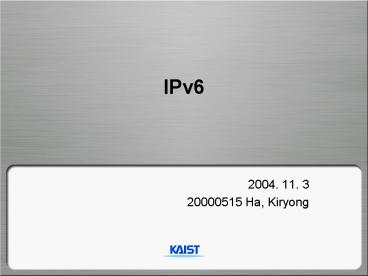IPv6 - PowerPoint PPT Presentation
1 / 10
Title:
IPv6
Description:
Korea Advanced Institute of Science and Technology. IPv4 vs IPv6 Format ... Korea Advanced Institute of Science and Technology. A new ICMP for IPv6. A new ICMP ... – PowerPoint PPT presentation
Number of Views:715
Avg rating:3.0/5.0
Title: IPv6
1
IPv6
- 2004. 11. 3
- 20000515 Ha, Kiryong
2
IPv6
- Motivation
- The 32bit IP address space was beginning to be
used up. - IP node being attached to the Internet at a
breathtaking rate.
3
IPv6 Datagram Format
- Version
- Putting 4 in this field do not make IPv4 (Life is
not easy like that) - Traffic class
- Similar in spirit to the TOS in IPv4
- Flow label
- Used to identify a flow
- Payload length
- Number of bytes following header
- Next Header
- Identify the protocol which the contents (data
field) of this datagram will be delivered (ex.
TCP, UDP) - Hop limit
- Source and destination address
- Data
4
IPv6 Datagram Format
- Feature
- Expanded addressing capabilities
- 32 bit ? 128 bit
- 340,282,366,920,938,463,463,374,607,431,768,211,45
6 - New type of address any cast which allows a
datagram addressed to an anycast address to be
delivered to any one of a group of hosts - A streamlined 40-byte header
- 40-byte fixed-length header allows for faster
processing of the IP datagram - Flow labeling and priority
- Allows labeling of packets belonging to
particular flows for which the sender request
special handling - Audio Video transmission. High-priority user
5
IPv4 vs IPv6 Format
- Fields appearing only in IPv4
- Fragmentation/Reassembly
- Do not allow fragmentation and reassembly at
intermediate routers ? Performed only in source
and destination - If too large to be forwarded, simply drop and
send ICMP error message - Removing this function speeds up IP forwarding
within the network - Header checksum
- Transport layer and Internet link layer perform
check sum ? Redundant work - Again, speeds up. ( checksum was performed every
router inIPv4 ) - Options
- Allowed but outside of header, indicated by Next
Header field
6
A new ICMP for IPv6
- A new ICMP for IPv6
- ICMP protocol is used by IP nodes to inform error
conditions and provide limited information to an
end system. - ICMPPv6 added new types and code for IPv6
- Packet Too Big type
- Unrecognized IPv6 options
- Subsumes IGMP protocol
7
Transitioning from IPv4 to IPv6
- Not all routers can be upgraded simultaneous
- How will the public Internet be transitioned to
IPv6? - Dual Stack allow IPv4 and IPv6 to co-exist in
the same devices and networks - Tunneling avoid order dependencies when
upgrading hosts, routers, or regions - Translation allow IPv6-only devices to
communicate with IPv4-only devices
8
Transitioning from IPv4 to IPv6
- Dual Stack
- Introduce IPv6-capable node, which also have a
complete IPv4 implementation - Use IPv4 when interoperating with IPv4 node, and
use IPv6 when interoperating with IPv6. - Using DNS, determine whether another node is
IPv6-capable or IPv4 only. - Problem IPv6-specific fields which do not have
counter part in IPv4
9
Transitioning from IPv4 to IPv6
- Refer to the intervening set of Ipv4 routers
between two IPv6 routers as a tunnel - Within the tunnel, Put entire IPv6 datagram in
the data field of an IPv4 datagram and Extract
IPv6 datagram
10
Conclusion
- Adoption of IPv6 has been slow to take off
because of advances such as CIDRized IPv4
address, DHCP, NAT contributed toward solving
depletion of IPv4 addresses. - Proliferation of devices such as IP-enabled
phones may push for more widespread deployment of
IPv6 - One important lesson How enormously difficult
to change network-layer protocol































